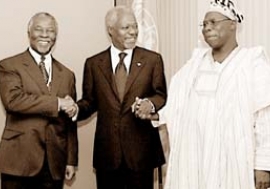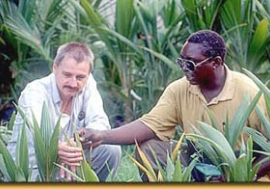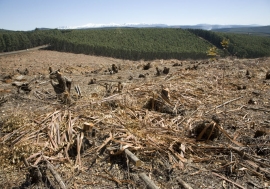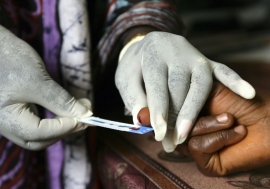How did partnerships work for Africa?
How did partnerships work for Africa?
A newly tested vaccine against Ebola and a giant drone that can beam Internet access to poor isolated areas — two projects announced just a few months to the expiration of the Millennium Development Goals (MDGs) — exemplify the initiatives unleashed by the goal on global partnership for development. But multiple frustrations have also accompanied the 15-year effort to advance the partnership.
Results of a trial vaccine developed by two pharmaceuticals and field-tested by the World Health Organization and Médecins Sans Frontières, a non-governmental organization that provides health care in poor countries, indicate a possible, but far from guaranteed, end to Ebola.
Drug development to defeat the Ebola virus had been negligible until the outbreak in three West African countries, as deaths prior to 2014 never went above the triple-digit range and the lack of a guaranteed market forestalled necessary research and development that might have found a solution. Currently, clinical trials for several candidate vaccines are in various phases and a safe and effective vaccine is hoped for by the end of 2015.
As regards the internet project, Facebook, the social media tech firm, has purchased Ascenta and Titan Aerospace, manufacturers of high-altitude solar-powered drones with the wingspan of a Boeing 737 and the weight of a standard car to bring the Internet to places where access is only a dream. Its very existence illustrates value of the MDG 8 target of making available the benefits of new technologies, especially information and communications, developed by the private sector.
The lightning-like spread of mobile phones in Africa made possible by government liberalization and private ingenuity, including many African firms, is well known. So is the impact: more shared knowledge, support for small-scale companies and farmers, and an expansion of economic and social liberties for many women.
Still, according to the International Telecommunications Union, barely more than 20% of Africans were online by late 2015 and this number is skewed by country. Nigeria, for example, was a top 10 Internet country in 2015 with 92% penetration, according to Internet World Stats. Tunisia was at the bottom with 5.2%. Further, the annual price of basic broadband in 20 countries, most of them sub-Saharan, was more than 50% of average personal income in 2013.
Strong progress has been seen on the MDG 8 target of providing access to affordable essential drugs in developing countries in cooperation with pharmaceutical companies. But growth in this area depends on the natural forces of innovation and competition the prospect of markets assured by donor countries, multilateral institutions and multi-sector partnerships the goodwill of companies and supporting companies based in countries where costs are lower and consumers are closer.
Reduction in the costs of medicines (as distinguished from vaccines) differs from disease to disease, according to the UN’s MDG Gap Task Force Report 2015 and in some cases it has been spectacular. At the start of the MDGs, adopted in 2000, the annual cost of antiretrovirals to fight HIV was $10,000 and fewer than one million Africans were receiving treatment. But partnership efforts, including those led by UNAIDS, a coalition comprised of 10 UN agencies against AIDS, using legal challenges to intellectual property and license rights, brought the cost down to $100 and some 10.7 million in sub-Saharan Africa now are being treated.
According to a recent UNDP report, the availability of essential medicines is still low in developing countries. According to the data on medicine availability and prices collected in 26 surveys from 2007 to 2014 in a sample of low- and middle-income countries, generic medicines were available on average in 58.1% of public sector facilities and in 66.6% of private sector facilities.
Nevertheless, there have been efforts to increase treatment access, in particular for some diseases such as HIV, tuberculosis and malaria, largely owing to a massive influx of national and international funding, such as from the Global Fund.
It should be noted that these outcomes are skewed by country. In Mali, for example, a 50% cost reduction in ARVs translates into about 45,000 CFA per month (about US$88). Yet, given that the cost is higher than the average monthly household income, ARVs are still inaccessible to 90% of the HIV-infected population of Mali.
Trade, finance and debt
For years, trade has been the key that unlocks new wealth, new technologies, and new ideas. By all appearances, the system was stacked in favour of the richest countries. The first MDG 8 target therefore was to “develop further an open, rule-based, predictable, non-discriminatory trading and financial system”.
Creation of the World Trade Organization (WTO) in 1996 replaced a previous trade pact — the General Agreement on Tariffs and Trade — with a more extensive guideline and rulebook covering trade relations. The African Growth and Opportunity Act instituted in 2000 by the US created openings for African products in US markets. According the UN’s MDG Report 2015, the margin of trade preference allotted to sub-Saharan Africa in the clothing sector in 2014 topped that of all other developing regions.
But protectionist measures persist, including suspiciously high standards of entry for imports from poor countries, and farm subsidies in rich countries that hold back African farmers who want to export.
Developing countries received duty-free treatment on only 65% of their exports to developed countries in 2000, but on 79% in 2014 (excluding arms). Duty-free imports from least developed countries increased from 70% to 84% of their trade over the same period, reports UNDP.
But, the merchandise exports of least developed countries accounted for only 1.17% of world trade in 2013. According to the report, there is the need for developed countries to eliminate more barriers to trade, while the remaining Doha Round issues need to be tackled.
Due to visible economic and political progress, investors have been eyeing Africa with more optimism. The UN Conference on Trade and Development annual reports show foreign direct investment to Africa rising from $9 billion in 2000 to $55 billion in 2014.
Freeing countries from crippling debt was another MDG 8 target. Under an initiative for heavily indebted poor countries spearheaded by the World Bank and the International Monetary Fund, debt relief has reduced financial pressures for 36 countries out of 39 highly indebted poor countries, 30 of them African, and achieved $76 billion in debt cancellations.
Only three countries—Eritrea, Somalia and Sudan—have yet to start the debt-relief process. The overall ratio of external debt to gross domestic product (GDP) of developing countries has declined over the past decade, but it has been increasing in some countries in recent years.
However, a number of developing countries, particularly small states, continue to face some of the highest debt-to-GDP ratios in the world, and their underlying economic problems warrant further attention. An urgent need remains for the international community to assist countries to enhance their policies towards debt-crisis prevention and to facilitate resolution of crises.
The partnership effect
As this review of targets indicates, MDG 8 was a “partnership” in fact as well as name, including North-South and public-private.
More generous official development assistance (ODA) for countries committed to poverty reduction is also listed in this target. ODA to the continent grew from less than $20 billion in 2000 to $56 billion in 2013. This is an increase that might have been considered utopian in 2000, but falls well short of promises made outside the MDGs framework.
WTO’s Abdel-Hamid Mamdouh points out that among the soft spots in the global partnership were weak regulatory regimes in Africa itself.
“Countries were moving quickly from centralized economies to market-based systems,” he told Africa Renewal. “But they often failed to realize that when you liberalize you actually need to regulate more, provide more guidance, because the government is no longer carrying out all the economic functions on its own.”
The governance effect, good or bad, can be seen in areas like trade, investment and productive capacity.
26 January 1950 – 4 November 2015
Timothy Wall, a long-time United Nations public information officer and a regular contributor to Africa Renewal on economic development issues, passed away on 4 November. He will be missed by many, including his colleagues at the United Nations. Tim is survived by his wife and a son. He submitted this story shortly after the September Summit on Sustainable Development. May His Soul Rest In Peace.




























